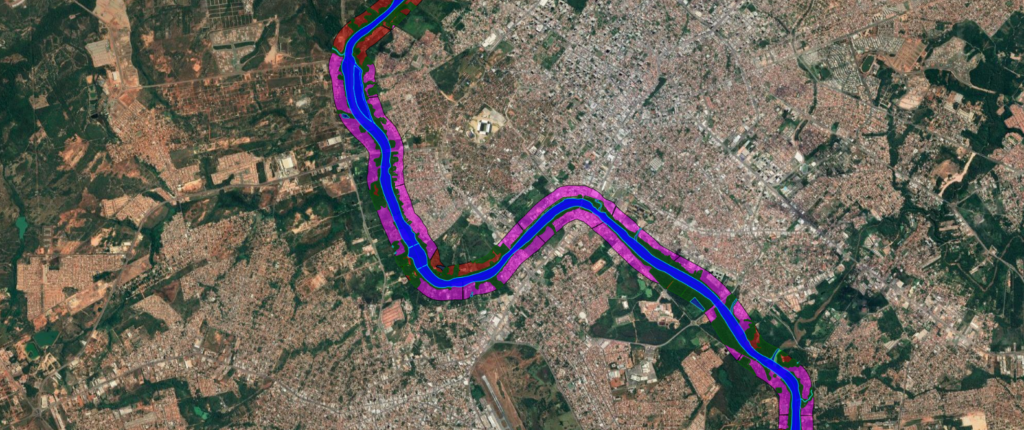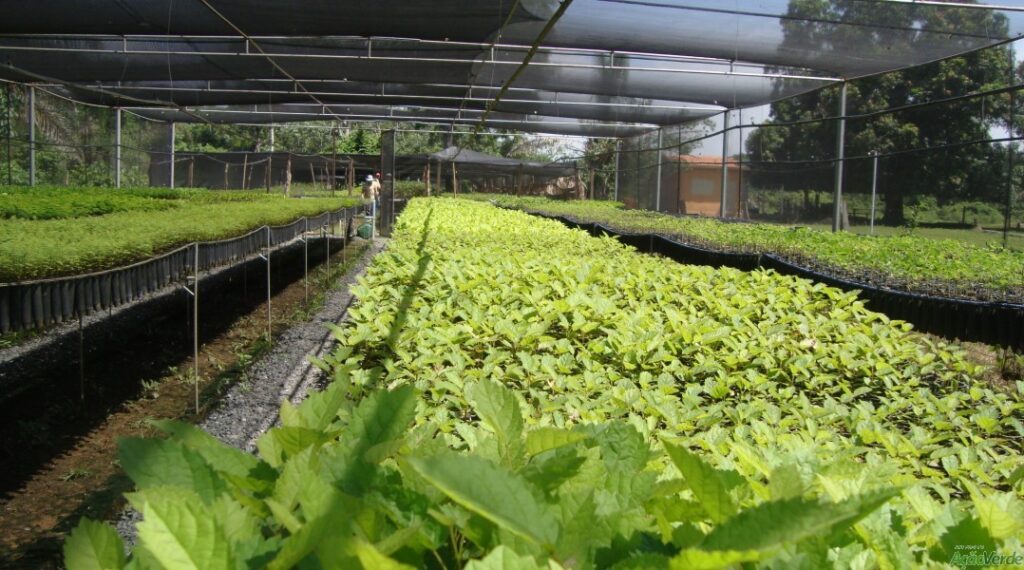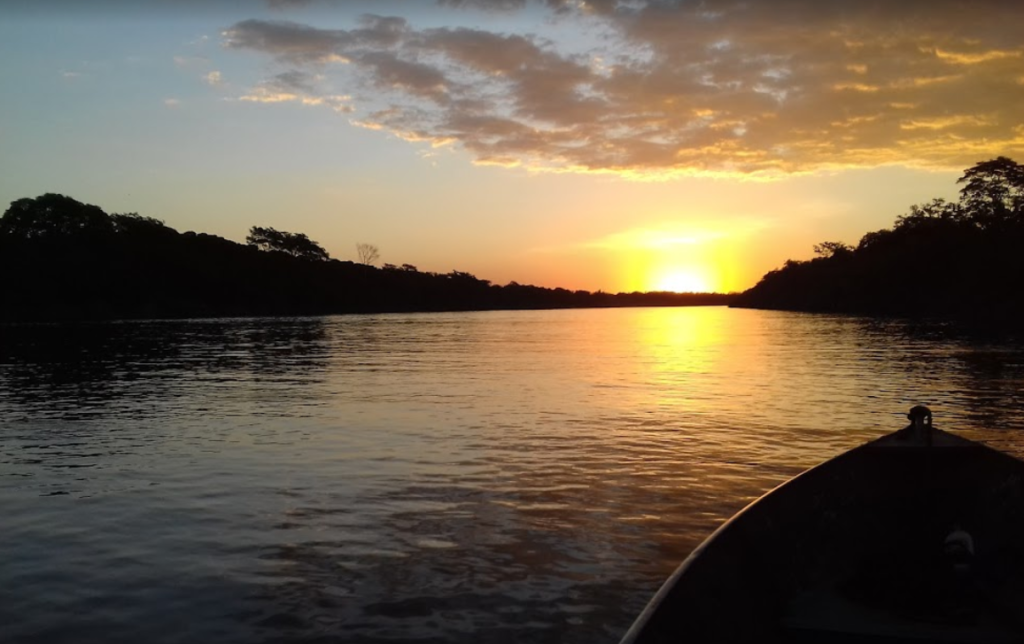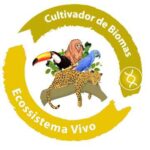projects
we carry out many actions in favor of the green of the forests, the blue of the rivers and the different colors of the animals
CAR map
The MAPADOCAR system is an initiative to improve the quality of maps of rural properties for the Rural Environmental Registry, with the objective of increasing the level of approval of these maps in the SIMCAR system of the Mato Grosso State Environment Department.
Green River Project
The Verde Rio Project aims to recover and preserve 100% of the riparian forests of the main rivers of Mato Grosso, bringing benefits not only to the local ecosystems, but also to the population of the State.
PNBSAE
Business Platform for Environmental and Ecosystem Goods and Services in Mato Grosso deals with the topic of Carbon, implementing a GHG program within the scope of the Instituto Ação Verde, to meet demands in the State, Brazil and any other interested country.
Green Education
It proposes to help social groups and individuals to acquire environmental awareness, knowledge and behavior, as well as to contribute to the consolidation of the environmental education process as a public policy through collective actions organized in educational institutions.
Technology + sustainable production + preservation
CAR map
The objective of the Instituto Ação Verde is to make available free of charge to professionals who prepare the CAR, a system working in the cloud on the internet, which will have specific tools and rules in its interface, which will facilitate, speed up and mainly guide the construction of the CAR. The main purpose of the system is to avoid errors in CAR construction as much as possible and guarantee a high number of approvals in the analysis of the works.
The system offers access to an extensive geographic database and images from several satellites, to be used as a background and made available in superimposed layers, coming from different sources and forms: Satellites, World and Federal Bases, Topographic Charts and RADAMBRASIL Vegetation, Bases State, Geographical Base 1:25,000 of the FBDS, Map of Biomes, Administrative and Road Political Map, among others.
Works 100% web
Advanced drawing tools
Various bases and reference images
Compatible with SIMCAR system
Access the MAPADOCAR system:
preservation + awareness + action
Green River Project
The Verde Rio Project aims to recover and preserve 100% of the riparian forests of the main rivers of Mato Grosso, bringing benefits not only to the local ecosystems, but also to the population of the State. Within this demand, the Verde Rio project was divided into: Pantanal, Amazon and Cerrado, in order to respect each of the 3 biomes of Mato Grosso and meet their specificities.
To succeed in this task, its creators mapped the main successful experiences in riparian forest recovery initiatives in Brazil and, in particular, in the State of Mato Grosso itself.
The Instituto Ação Verde defined the Cuiabá River as the first stage of the project, the Verde Rio Pantanal, which encompasses the Cuiabá, Paraguai and São Lourenço rivers.
The Cuiabá River is the main source of fresh water for two of the largest cities in the state, the capital Cuiabá and the neighboring municipality, Várzea Grande, which today has about 2,000 ha in need of immediate intervention. And for the recovery of its margins, a series of measures are being taken.

Among the actions proposed for the reforestation and preservation of the Cuiabá River Basin, the Institute has already carried out: a survey of the Cuiabá River area using satellite images; seminars and mini-courses; implemented the seedling nursery in Santo Antônio de Leverger; collected seeds of species native to the region; carried out the phytosiological survey; registered more than 2 thousand properties on the banks of the Cuiabá river; planted seedlings and provided technical assistance to residents.

For reforestation, the seedlings are being produced in the Institute's own nursery, located in the Barranco Alto region, in the municipality of Santo Antônio. The seedlings are produced for free distribution to project participants. 130,000 seedlings were planted in the municipality of Santo Antônio de Leverger, where the pilot project was implemented. The Verde Rio Amazônia was launched, serving the Aripuanã, Teles Pires and Xingu rivers.
Other rivers included in the project were: Juruena, das Mortes, Araguaia, Piqueri and Vermelho.
The Verde Rio Project showed the world that, in addition to being a great food producer, Mato Grosso is also a great protector of nature and the people, and here economic and social development is a great ally of environmental preservation.
The Verde Rio project is developed based on a methodology of successive stages.
SURVEY THROUGH SATELLITE IMAGE
- Survey the entire length of the river, from its source to its mouth, in Km.
- Plot the entire APPD – Degraded Permanent Preservation Area, with Geographical Coordinates.
- Calculate in hectares how much APP needs to be recovered.
SEMINARS AND MINI-COURSES
Holding of a Seminar to launch the project, with the participation of various authorities, including state leaders, mayors, secretariats of the Environment, representatives of the Public Ministry, among others. With advance disclosure and assembly of mini-courses or lectures.
NURSERY IMPLEMENTATION
The Forest Nurseries are areas with a set of improvements and tools, which employ techniques aimed at obtaining the maximum from the production of seedlings. In the permanent nursery, seedlings are produced continuously and indefinitely and in the itinerant nurseries, the actions will follow according to the locations contemplated in the project.
COLLECTION AND PROCESSING OF SEEDS
The seed collection areas will be located at strategic points, covering the three ecosystems (Cerrado, Pantanal and Amazon Forest).
PHYTOSOCIOLOGICAL SURVEY AND DEGRADATION LEVEL OF APPDs
In principle, all species native to the region and naturally occurring in riparian forest areas are potential uses. Floristic and phytosociological studies in areas of remaining riparian forests in the region will identify the species most adapted to the conditions of the local sites.
The assessment of the conditions of Permanent Preservation Areas, such as: topography, water regime, soil type, natural fertility, presence of erosive processes, surrounding human activities, climate, presence of pests and capacity for natural regeneration are fundamental for the preparation recommendations and soil correction. Area protection, species selection, spacing, planting arrangement and future management will be carried out in all APPD areas, by technicians hired by Instituto Ação Verde.
SOCIOECONOMIC AND ENVIRONMENTAL REGISTRATION OF PROPERTIES
They are carried out in loco, through visits in 100% of the properties that have Permanent Degraded Preservation Areas, along the rivers. Residents answer a questionnaire that surveys the socioeconomic and environmental situation of the property, for later creation of a report and preparation of adequacy plans, if applicable.
PREPARATION OF ADEQUACY PLANS IN APPD'S
In several properties, there are many disagreements with environmental legislation and, in view of this, the Ação Verde Institute, together with its partners, prepares an Adequacy Plan for properties that have a historical, cultural or economic connection with the area.
PLANTING, MAINTENANCE AND TECHNICAL ASSISTANCE
Planting is carried out by the owners of the areas, but all receive technical assistance. At all stages of the recovery process, all plantations are maintained for three years and these services are performed by a technical team from Instituto Ação Verde.

The historical importance of the Cuiabá River for Mato Grosso and Brazilian society is secular. It is a river that is historically represented as a source of life and resources for the city. It is the river that feeds, that fights the thirst of the population and also helps to alleviate the heat. Therefore, it is the river that bathes and purifies the soul and heart of our people.
The Cuiabá River was the main communication route from the capital to the center-south of Brazil. Where, at the beginning of their occupation, the pioneers from São Paulo, following the so-called monsoon route, left São Paulo and landed in Cuiabá.
Along this river, the expert canoe Indians, the Paiaguá, plied the currents with agility and dexterity, having become famous, also, for the attacks that carried out the monsoons.
River navigation, in the beginning, was done in small sailing boats (Igarités), which were sometimes paddled or driven by the wind; down the river with their passengers, entire families and their luggage. There were also other smaller boats, just rowing, such as canoes, canoes, boards, boats. However, the first steamship that entered Mato Grosso waters was the Waterwitch, of the North American Navy, in 1853.
The Cuiabá River also served for the production of energy, that is, the riverside communities were dedicated to the extraction of fish oil, the fuel necessary for lighting homes and a few points on the capital's main streets.
Rio Baixo and Rio Acima served the entire Cuiabana community, riverside communities, the embarkation and disembarkation of people, authorities, liberal professionals, workers, slaves, machines, traders, clothes, medicines, brown sugar, sugar, brandy, tools, in addition to various foods such as salt, essential for the well-being of the population.
In addition, the Cuiabá River served and still serves as a cultural source for the population of Mato Grosso. However, the river still brought modernity to the territory of the far west as steam engines, the printing press, the telegraph, mill machinery, pianos, cultural groups, water pipes and electric light. Finally, by the river, great part of the advances that the world already knew reached Cuiabá Antiga.
CUIABA RIVER BASIN
The Cuiabá Basin includes the main stretch of the Cuiabá River and its tributaries upstream from Porto Cercado, covering about 100,000 km2, covering 828 km until reaching the Paraguai River. The basin covers 14 municipalities. The basin includes some environmental protection zones – the Pantanal Mato-grossense National Park, located near the mouth of the Cuiabá River; the Chapada dos Guimarães National Park, located in the upper part of the basin and an Environmental Protection Area (APA) adjacent to it.
The city of Cuiabá is rich in water resources: several rivers, streams and streams that form the basin of the Cuiabá River bathe it. The Cuiabá River, an important tributary of the Paraguai river basin, part of the Platina basin, limits the municipality to the west. The hydrographic basin formed by the Cuiabá River is subdivided into Upper, Middle and Lower Cuiabá. The river has its source on the slopes of Serra Azul, municipality of Rosário Oeste, at the junction of the Cuiabá da Larga and Cuiabá Bonito rivers. In the municipality of Nobres, more abundant due to the affluence of the Manso River, it is renamed the Cuiabá River. With an average width of 150 m, its main tributaries are the Pari stream and the Manso, São Lourenço and Coxipó rivers. The latter, cutting through the municipality of Cuiabá, has its head in the Chapada dos Guimarães National Park and its mouth close to the community of São Gonçalo Beira-Rio.
CURRENT SITUATION OF THE RIVER CUIABA AND ITS CHARACTERISTICS
The environmental and water situation of the Cuiabá River Basin results not only from human occupation, but also from the topographical characteristics of the region. Water quality in the upper reaches of the basin is affected by sedimentation and changes in land use patterns. The sandy soils and rugged topography of this region produce high rates of sedimentation, mainly with the removal of forest cover from riparian forests. Along its 828 km of extension, Rio has an area of 16,000 ha of Permanent Preservation (APP), of which approximately 2,000 ha are degraded, requiring some type of human intervention. The Cuiabá river basin is home to about 75% of the population of the State of Mato Grosso.
River Characteristics: Average width of 150 meters.
Degrading Agent: Sedimentation and Sewage.
Type of Occupation: Superior (Near East) – Agriculture and Livestock – Medium (Cuiabá and Várzea Grande).
Alicia Clara, who was 8 years old at the time – a resident of the Barranco Alto community, in Santo Antônio de Leverger, sent the Institute a message calling for the preservation of nature. She participated in a Field Day and helped plant seedlings of native trees in her community. Recognizing the initiative, as a result of the entity's environmental awareness work, we put her message below:
NATURE
“Nature is the only book that offers valuable content on all its pages.
When attacked, nature never defends itself, it only takes revenge.
Never accuse nature, she does her part. It is up to man to do his part.
All of nature is a divine harmony, a wonderful symphony that invites all creatures to accompany its evolution and progress.
Nature is totally natural, it does not contribute to global warming.
Make nature bloom every day.
Do like me, protect nature.
That's my message.”
Alicia Clara
Some actions carried out over the years of the Verde Rio Project:
Access the interactive map of Projeto Verde Rio:
carbon market + greenhouse gases + future
PNBSAE
The Business Platform for Environmental and Ecosystem Goods and Services in Mato Grosso (PNBSAE/MT) was created with the aim of promoting the Green Economy in Mato Grosso and is initially responsible for implementing the State's voluntary GHG Program. It works as a meeting place for all those interested in combating climate change, and they provide certification seals to participants, as a way of publicizing the actions they take in this regard.
UNIMED, in 2011, was one of 19 companies to receive the “Live Forest – Neutral Carbon” seal, in recognition of the positive results of neutralizing greenhouse gas emissions.

The PNBSAE/MT was created in the Statute of the Instituto Ação Verde, aimed at promoting the Green Economy in the State of Mato Grosso. The platform will address the issue of Carbon, implementing a GHG program within the scope of the Instituto Ação Verde, to meet demands in the State, Brazil and any other interested country. The GHG program does not establish ceilings or impose mandatory charges on companies, being voluntary and exercised in order to promote Corporate Social and Environmental Responsibility of companies, organizations and institutions that join the PNBSAE/MT.
It started operating on May 24, 2012, starting its operations presenting an offer of PINs totaling more than 5 million tCO2eq from projects in 7 Brazilian states (Mato Grosso, Mato Grosso do Sul, Pará, Paraná, Santa Catarina, Bahia and Minas Gerais ). Around 500 thousand tCO2eq already sold and certified, and something like 2 million tCO2eq under negotiation. On May 22, 2012, the work on the Cartesian wells of the first two communities to receive resources from carbon credits from the reduction of emissions and the increase in forest carbon sequestration and stock was delivered.
The Platform was presented at Rio+20, the United Nations Conference on Sustainable Development, with support from the Confederation of Agriculture and Livestock of Brazil (CNA) and the Federation of Agriculture and Livestock of Mato Grosso (Famato).

The Verde Rio project had its carbon credits calculated, and in 2011, Instituto Ação Verde had already started its carbon credit bank, which would become the PNBSAE. See the report that came out in the media at the time:
The PNBSAE/MT was adopted by means of an amendment to the Statute, by the Instituto Ação Verde, as an instrument for promoting the Green Economy in the State of Mato Grosso. PNBSAE/MT operates and manages a GHG Program in the State of Mato Grosso, collecting a maximum of up to 25% from the value of transactions carried out and passing on a minimum of 75% to the project activity developers.
The PNBSAE/MT works based on the recognition of the need to implement Corporate Social and Environmental Responsibility actions that follow methodologies for the development of project activities that are Measurable, Reportable and Verifiable. These methodologies are registered in the PNBSAE/MT, which publicizes those that can be used to develop GHG project activities within the transfer mechanism. The Figure demonstrates how the mechanism works:

Buyers are represented by all sectors of the economy, including industry, construction, commerce, transport, energy, waste, agriculture, livestock and forests, including timber. These actors seek to integrate the PNBSAE/MT through the preparation of a GHG inventory, which is prepared by consultants registered with the PNBSAE/MT. The inventories prepared by the consultants are sent for audit by third parties, also registered in the PNBSAE/MT. These audited inventories are then sent to an independent registry, and appear in the PNBSAE/MT, publicizing their data. The inventories are then transferred to the PNBSAE/MT advertising system, and generate a Debit account, which is registered by a third party.

On the sellers side, the process involves the preparation of a Project Idea Note – NIP (PIN), and sending it along with supporting documentation for a preliminary audit. After the preliminary audit, the PIN is registered with a third party, which affixes a code to the PIN and returns it to PNBSAE/MT to publicize the data. The next step is the preparation of the final project, which involves the implementation of the Baseline and Monitoring methodology registered in the PNBSAE/MT and submission for final audit. After the audit, the project goes to third-party registration, and then returns to PNBSAE/MT. The publicity of the carbon credits of the project thus constructed generates a Credit account, which is registered by a third party.
After these procedures, the Debit and Credit accounts can carry out transactions with each other, seeking to neutralize carbon. The accounts thus crossed send a request for the issuance of a seal to the PNBSAE/MT. There are two main types of seals: CO2 Biome Cultivator Seal – Living Ecosystem, for sellers of carbon credits and; CO2 Responsible Company Seal: Living Ecosystem, for buyers of carbon credits.
PNBSAE/MT is responsible for monitoring the functioning of the mechanism, ensuring buyers that carbon credits are being maintained in accordance with the provisions of the PIN and carbon projects. The PNBSAE/MT must also guarantee possible losses due to negligence, accidents, atmospheric phenomena and others that may compromise the carbon stored or sequestered by the registered project activities. Damping quotas to guarantee this flow must be included in the specific regulation on the management of the PNBSAE, to be prepared within a period of up to 01 (one) year after the approval of this regulation.
FNBSAE/MT collects a fee of 0.5% from the commercialization of credits, for system maintenance, training of human resources and Research & Development, as well as for investments in projects and initiatives aimed at advancing the Green Economy in the State of Mato Grosso .
Access the Business Platform in Environmental and Ecosystem Goods and Services of Mato Grosso
awareness – new generations – responsibility
Green Education
In order for environmental education actions to be effective, it is necessary that the interventions be carried out not only in the areas that are the object of forest restoration policies for the conservation of water resources. It is extremely important that the pedagogical process also involves large urban centers as these agglomerates are major polluting and degrading agents of natural resources.

Based on this, the present project, called Educação Verde, proposes to help social groups and individuals to acquire environmental awareness, knowledge and behavior, as well as to contribute to the consolidation of the environmental education process as a public policy through collective actions. organized in educational institutions.
Project's goal
Help social groups and students aged 4 to 12 to acquire environmental awareness, knowledge and behavior, as well as contribute to the consolidation of the environmental education process as a public policy through collective and organized actions in educational institutions. The specific objectives of the project are:
- Sensitization of students and the population in the involvement in participatory processes of environmental education;
- Foster agents capable of planning and executing socio-environmental actions in their work, study and/or home environment;
- Make the actors involved aware of their role as a transforming subject;
- Foster the acquisition of multiple experiences in relation to environmental problems;
- Provide opportunities to acquire knowledge for the appreciation and respect for the environment;
- Foster multiplying agents of the knowledge socialized by the program for the dissemination of information, awareness and social mobilization;
- Contribute to the autonomy of school units through practices aimed at environmental, economic and social sustainability.

Activities
- Planning of environmental education activities with representatives of school communities;
- Execution of theoretical and practical activities of a pedagogical nature, together with the school community, covering the following topics:
- Production of seedlings of forest species;
- Recovery of degraded areas;
- Tree planting in schools;
- Implementation and management of school gardens;
- Installation and management of composters.
Expected results
The great expected result is the change in the awareness of the interface with nature and the execution of projects that allow the maintenance of the activities developed in the municipalities, but with sustainability and respect for the environment. In addition to these, we can highlight:
- Production and editing of educational material;
- Maintenance of activities developed in institutions, enabling the execution of projects;
- Sensitization of students regarding the benefits of urban afforestation, preservation of water resources and organic crops;
- Alleviation of heat and microclimate control of schools through afforestation;
- Implementation of small cropping systems (school gardens) to complement school meals;
- Training multiplier agents of the knowledge socialized by the program for the dissemination of information, awareness and social mobilization.

Target Audience
Students aged 4 to 12 from institutions, preferably public, lacking environmental education. The project, through its innovative methodology, will seek to reach the entire environment of coexistence of these children from their childhood to adulthood. So, in addition to educational institutions, student residences will also benefit through the multiplication of techniques developed in the school environment.




















